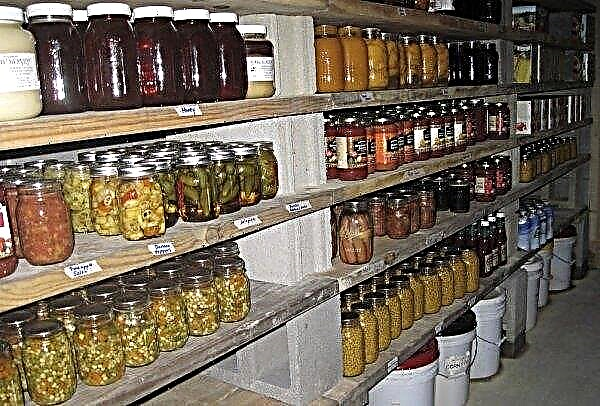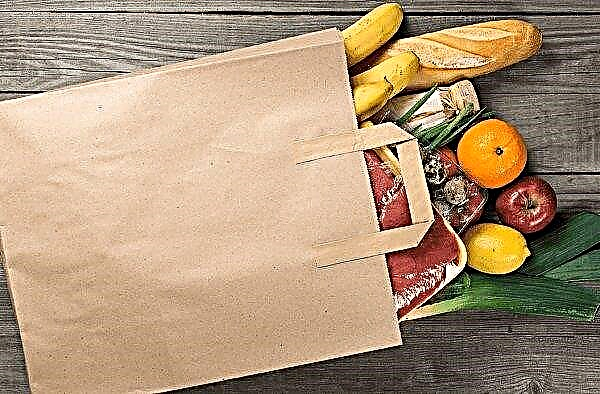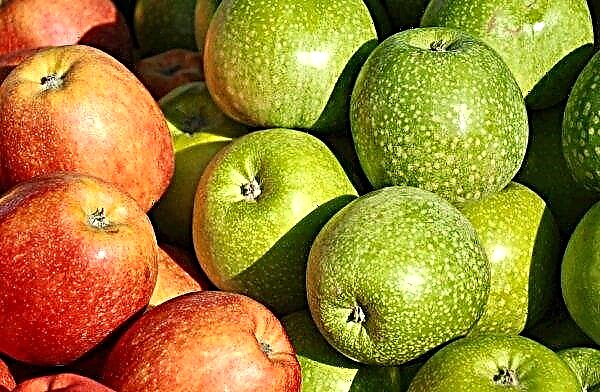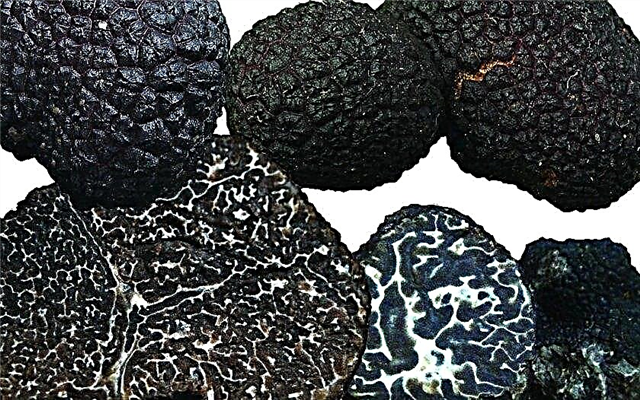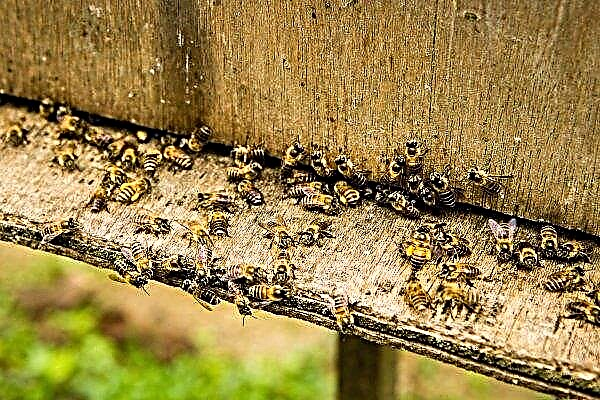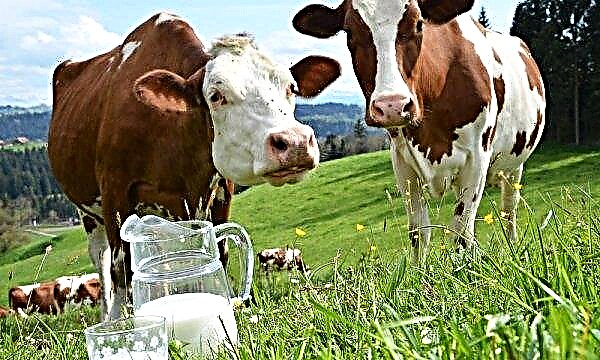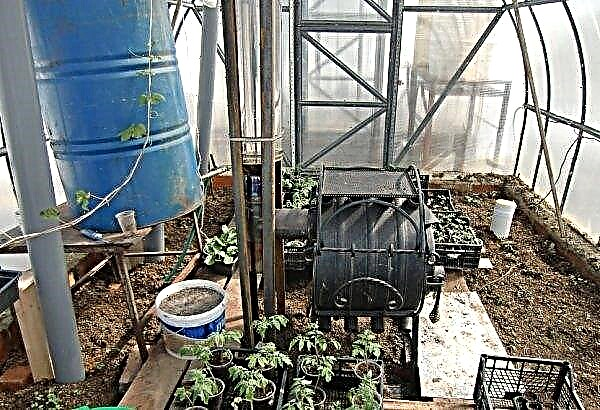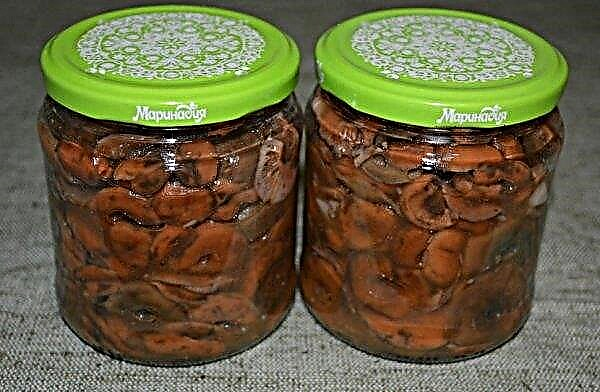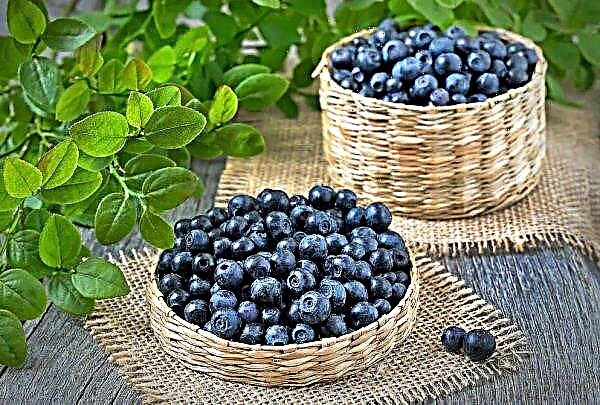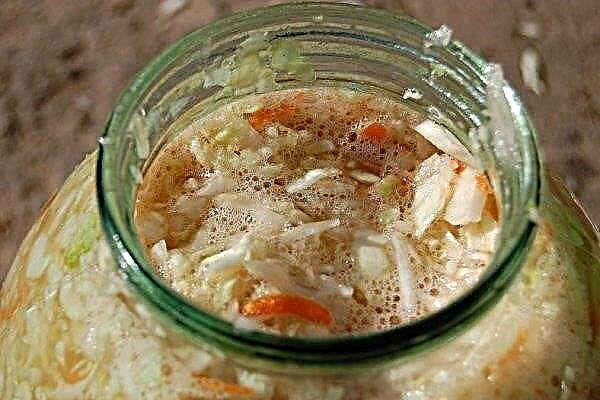Farm greenhouses are usually built to grow vegetables, berries or greens year-round. Such facilities make it possible to guarantee a large crop of garden crops and deliver these products to markets. What such greenhouses are and how to build them is described in this article.
Features of farm greenhouses
Capital farms are considered as farm greenhouses, which, depending on the occupied area, can be divided into 2 types:
- semi-industrial - their area occupies no more than 500 m²;
- industrial - an area of more than 500 m².
Both types of greenhouses can have either a prefabricated or a stationary structure. The main feature of all farm greenhouses is a solid foundation, which can be slab, strip or pile, depending on the type of structure.Did you know? In the Sahara desert, the Green Sahara greenhouse complex has been created. Greenhouses are cooled with sea water, and sea water, desalinated by electricity from solar panels, is also used for irrigation.
- Among the advantages of such greenhouses are:
- increased strength of the entire structure;
- higher yield compared to a conventional greenhouse. [/ ul
- However, farm greenhouses have some disadvantages:
- higher cash construction costs;
- long construction period.
Semi-industrial
Semi-industrial greenhouses belong to agricultural facilities and are used by farmers who sell the grown crops. The most common semi-industrial farm greenhouses are structures up to 30 meters long and about 8 meters wide, they use fertile soil. The film or spunbond is most often used as a coating - a special non-woven material that does not transmit ultraviolet rays, thereby protecting young plants from sunburn. Also, cellular polycarbonate may serve as a coating, the thickness of the sheets of which does not exceed 6–8 mm.
As practice shows, the use of semi-industrial farm greenhouses does not pay off for the first season. Getting net profit will have to wait several seasons.

Industrial
Industrial farm greenhouses are significantly larger and are produced, and also installed with the help of qualified specialists. The shape of the roof can be arched or gable. The first option is more common due to the ability to evenly distribute the load from snow and water, and also as a less costly option. Polycarbonate is usually used as a coating, the thickness of the sheets of which should be higher than in semi-industrial greenhouses - more than 8 mm.
An important feature of such greenhouses is a certain microclimate, which is achieved through various communications - lighting and heating systems, as well as irrigation and ventilation devices. Thanks to such equipment, it is possible to harvest several times a year.

DIY farm greenhouses
Convenient and durable greenhouse will always find application in any household. And if you build it yourself, using affordable, but high-quality materials, its cost will be quite low. That is why many gardeners prefer to build greenhouses on their own. Consider below the basic rules for the installation of such structures.
Site selection and preparation
Before proceeding to the calculations and drawing up the drawing, the first thing you need to decide on the choice of place for future construction.
To do this, consider the main selection criteria:
- type of greenhouse being built - seasonal or year-round;
- climatic zone and its features;
- Features of growing selected crops and the choice of technology.
It should also take into account the future location of the structure in relation to other outbuildings, the proximity of the location of light and water sources.
Best of all, as a place under the greenhouse, a well-lit and windproof area is suitable. It is recommended to position the greenhouse in the direction from the east to the west - this will guarantee good lighting throughout the day.

Sizing and designing
The next step in choosing a construction scheme is to determine the required dimensions.
It depends on the following criteria:
- Crops to be grown in the greenhouse. Vegetables such as tomatoes or cucumbers require a spacious room with a good shelter, while when growing greens or radishes, you can do with a small building on the arches. The width of the beds and aisles is also taken into account.
- The types of crops that will prevail. This should be based on when calculating the height of a future building - some bushes of vegetables can reach a height of 1.5–1.7 m. To this should be added about 30 cm of free space from the tops to the ceiling of the greenhouse.
It is necessary to pay attention to this factor: an individual project assumes any size, but, based on the experience gained by gardeners, it is worth building such greenhouses whose length exceeds the width by 2 times (for example, 3 × 6, 4 × 8).
After the final choice of the place and model of the future design, you need to draw up a drawing that will help with the purchase or selection of the necessary parts for construction, as well as in the manufacture of blanks and assembly. The working scheme does not have to meet all the rules of drawing - it can be a hand-drawn plan on which all sizes are calculated and affixed.Step-by-step instructions for building a farm greenhouse
After drawing up the necessary drawings and diagrams, carrying out calculations and preparing materials, you can proceed directly to the construction of the greenhouse.
Video: How to build a winter farm greenhouse
The stages of construction include the following actions:
- Mark the selected area - for convenience, it is recommended to use taut ropes. The ends of the twine need to be tied to oppositely placed stakes. Segments should intersect in the center of the perimeter - this factor indicates the correctness of the markup.
- Remove the upper fertile layer with a shovel - in the future, this soil can be used as a filler of beds.
- According to the marking, dig a trench, the width and depth of which is 30 cm. In the case of a high sand content in the soil and, as a result, shedding of trenches, they must be covered with polyethylene or other insulating material.
- Align and tamp the bottom of the ditch.
- Top with a layer (about 10 cm thick) of wet sand.
- Next comes a layer (about 5 cm) of fine-grained gravel.
- Lay a waterproofing material on top, which can be used as a roofing material.
- To make the formwork, which will not allow the liquid foundation to spread. As a frame, edged boards or plywood are usually used, which must be strengthened with spacers from the outside and placed under the film (or any other waterproofing material). The height of the formwork should be 6–10 cm higher than the expected foundation height.
- As a reinforcement of the concrete base, a metal structure is used - reinforcing bars with a thickness of at least 0.9–1.2 mm must be connected by welding. When laying a metal frame, one must take into account that the reinforcement should not reach the bottom of the trench, for which brick supports are used. After laying, reinforcing bars should be attached to such a frame. The length of the rods is 80–90 cm, and it exceeds the foundation level by 40–50 cm.
- Pour the formwork with concrete and leave it for a period of 7–9 days, until it solidifies.
Important! The marking of the site for the construction of the greenhouse should be performed in the form of several squares. The intersection of the cord sections should form an angle of 90 °.
After preparing the foundation, taking into account the selected shape and material of the structure, work is carried out on the manufacture and installation of the frame, its strengthening, as well as the installation of a protective coating.
Development of the foundation for the greenhouse
Depending on the chosen method of construction and materials, there are several types of foundations:
- brick foundation - A relatively inexpensive option with a fairly easy way of laying;
- stone foundation - requires some styling skills and material costs, however, it is durable;
- point foundation - gives good stability, but is not able to protect crops from the negative effects of external factors (for example, cold soil);

- strip foundation - refers to the most popular types of reinforcement, provides a high level of heat conservation and reliability of supports;
- foundation of timber - refers to the simplest ways to strengthen the structure, but has a short service life (up to 5 years);
- foundation of blocks - strong and durable, but quite expensive.
Did you know? The world's largest greenhouse called Eden is located in Cornwall in the UK. The greenhouse of several geodesic domes covered with a special film covers an area of 1.5 hectares.
Fabrication and fixing of the frame
In the construction of greenhouses, one of the three frame options is most often used:
- wood;
- metal;
- PVC
The most common are frames made of polyvinyl chloride, or PVC. They are durable and lightweight, do not require additional processing, and also do not lend themselves to decay processes, unlike wooden ones. Metal frames are used a little less often, because, having durability, they belong to a higher price category.
In the manufacture of a greenhouse using a wooden frame, window frames with previously removed hinges, handles, latches, etc. are very often used. The surface of the frames must be thoroughly cleaned of old paint and treated with an antiseptic that protects the wood from rodents and insects. Before installing such frames, you need to build a solid wooden frame from a bar, the parameters of which reach 50 × 50 mm. Screws or galvanized nails are used as fasteners.
In the event that a metal frame is selected, profile pipes of 20 × 20 mm with a wall thickness of 0.5 to 2 mm and a length of up to 6 m will be required. Profiles with a rectangular or square section are used. For additional protection against corrosion, powder coating or galvanizing is used. You can assemble such a frame with the help of bolts, without the use of welding. To increase the strength of fixing to the foundation, it is recommended to use anchor bolts or pre-fixed studs.
When using PVC as a frame, polypropylene pipes with a length of 1 to 6 m, the diameter of which can vary from 25 mm to 32 mm, will be required. Depending on the chosen design, plastic clamps or aluminum bolts are suitable as a fastener.
Choice of casing
There are several main types of cladding that is used in the construction of farm greenhouses. Consider the most common materials that cover buildings of this type.
Polycarbonate lining
Today, the most commonly used covering material is polycarbonate. Due to its characteristics, it is easy to mount, has reliable operation and durability, which protects it from destruction in the event of sudden impacts (for example, large hail).
Foreign-made cell polycarbonate has a different structure and thickness, which varies from 3.2 mm to 25 mm. The light transmission coefficient also depends on this indicator - it will fluctuate from 62 to 83%. If it is necessary to shelter an industrial greenhouse with a small area, a polycarbonate sheathing with a thickness of 3.2-6 mm is used.
Film
A polyethylene film has been used as a covering material for a long time. However, it has several disadvantages, the main of which is low strength.
Many operational actions, from fixing and ending with exposure to the negative effects of the environment (such as wind), lead to stretching of the film and its damage. When using such material in the area of strong winds, greenhouses annually need to be shut off, which is associated with high costs.

Glass
Such a coating has the highest transmittance (up to 92%, depending on the thickness of the material), and is also able to quickly heat air in a greenhouse. The disadvantages of such sheathing include the need for a stronger frame, the difficulty of replacing glass and removing fragments in the event of its breaking, as well as the possibility of overheating of plants with improper ventilation.
Equipment and accessories for farm greenhouses
There are a number of systems with which you can set the necessary microclimate in greenhouses and provide the ability to regularly produce high-quality crops.
Ventilation system
Each greenhouse, regardless of its type, should have small windows with which airing is carried out. Ideally, maintaining the required temperature should be carried out without human intervention. For this purpose, numerous ventilation systems have been developed, which include special sensors and a whole range of vents, each of which is equipped with an automatic pusher.
This system uses sensors to monitor elevated temperatures that trigger the pusher mechanism — the air vents open or close as needed.
Important! To always receive a large and high-quality crop, regardless of weather conditions outside the greenhouse, you need to correctly select and install all systems, as well as regularly monitor their work and timely eliminate all problems.
Heating system
Such a system is a prerequisite for year-round greenhouses and can be heated using gas, electricity or solid fuel, and water, steam or air can act as a coolant. When choosing a heating system, the main criterion is the speed of space heating. The fastest is air heating, with which the temperature can rise significantly in just a few minutes.
Water heating is considered to be the most reliable, which has a large heat transfer - even after turning off, such a system continues to warm the air for some time.
The most modern solutions include the infrared heating system (IB), which allows you to quickly and evenly increase the temperature of the room, and also heats the soil. As such equipment, infrared heaters are used.

Irrigation system
There are several basic principles of irrigation systems that can provide plants with sufficient moisture:
- Drip irrigation - refers to the most beneficial irrigation method. Thanks to the spot irrigation method, all crops are provided with sufficient moisture. Such a system can be ordered ready-made from specialists, or mounted independently.
- Sprinkler system - well suited for crops that need the most natural watering. Sprinklers spray moisture from above, simulating rain.For the smooth functioning of such a system requires a constant and strong pressure of water. This method of watering is not suitable for all cultures, since a large amount of water remains on the leaves, which can provoke the occurrence of various fungal diseases.
- Subsoil irrigation - refers to the most effective method and has several advantages, among which are: uniform and constant hydration of the root system of plants, the inability to grow weed grass, the minimum amount of water used.
Greenhouse lightening system
As the main element of the lighting system, lamps are used. Since today there is no lighting device that could completely replace sunlight, farmers often combine different types of lighting, trying to achieve the most comfortable conditions for plants.
Among the many lighting fixtures, there are several commonly used lamps:
- fluorescent lamps - relate to universal lighting devices for lighting greenhouses of any format;
- ultraviolet lamps - used as disinfection devices, destroy harmful bacteria;
- mercury lamps - have a radiation spectrum that is well suited for photophilous crops;
- high pressure sodium lamps - not only provide the necessary lighting, but also warm the air well, while they have drawbacks: they attract insects and adversely affect the development of young cultures;
- LED lamp - fairly new lighting devices, which are gradually gaining wide popularity due to their spectrum of light radiation and long life;
- infrared lamps - belong to the most correct solutions for lighting greenhouses, as they are able to provide the most natural conditions.
Important! In addition to the above systems, for good and uninterrupted operation of farm greenhouses it is necessary to use carbon dioxide fertilizer systems for crops, electric lighting systems, humidification systems, automatic climate control and many others.
How to choose the right farmhouse greenhouse from the manufacturer
When starting the selection of a greenhouse, it is necessary to take into account the following criteria:
- Frame material - The best option for stationary structures that are not planned for dismantling in the winter is a frame made of high-quality galvanized iron. Such material will provide structural strength, easily withstand snowfalls and strong winds.
- Covering material - polycarbonate, which has a number of advantages over other cladding, will be the optimal solution: high thermal and sound insulation, tolerance of temperature changes and fire resistance.
- Size and shape, both on a large farm and on a mini-farm, must meet the site chosen for construction and the personal preferences of the gardener. But first of all, you should pay attention to the angle of inclination of the surfaces, which should allow the snow to spontaneously slide down, providing protection from the collapse of the roof.
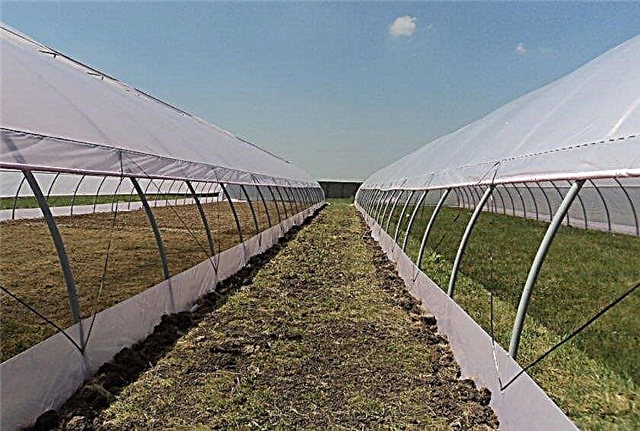
Maintenance and care of the farm greenhouse
In addition to all the preparatory work for installing the greenhouse, it is also worth knowing the basic rules for caring for such a structure.
There are several recommendations that will help preserve the covering material at the construction site and not to change it for a long time, as well as additionally moisten the plants:
- the inside and outside should be washed regularly with a soft sponge, water and a soap solution (without the use of detergents, the use of which can adversely affect the plants grown);
- with a large amount of snow it must be swept away from the roof of the greenhouse so that it does not accumulate;
- snow swept away from the greenhouse can be brought inside - under the influence of sunlight it will quickly melt and moisten the soil.



